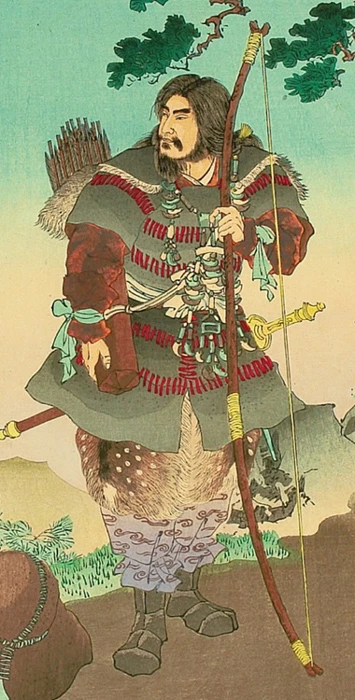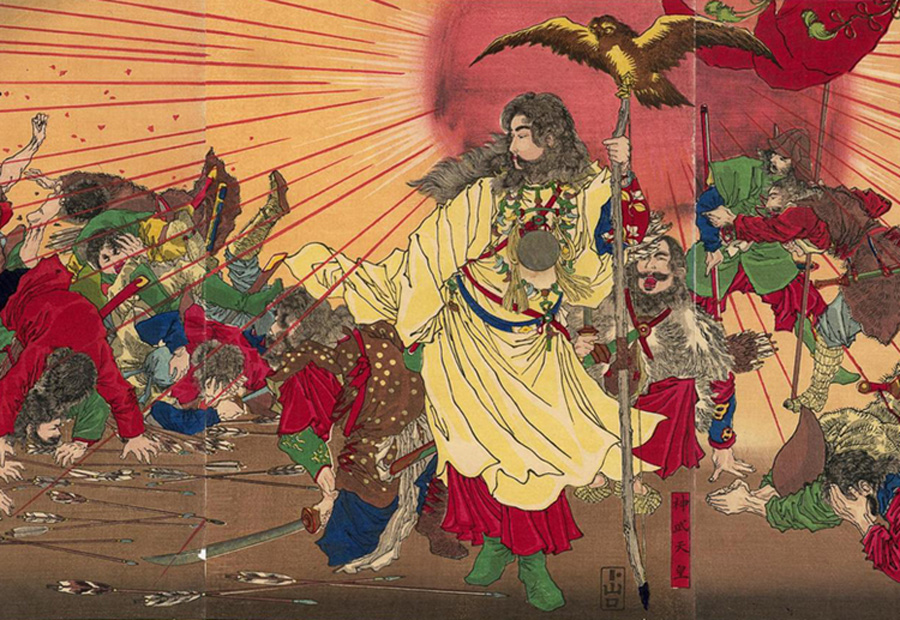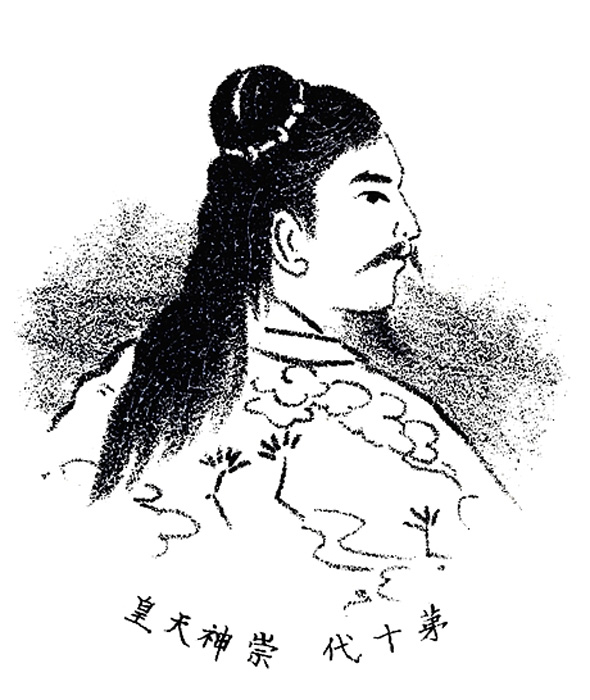As long as the country of Japan has existed, it has been ruled by emperors. The current emperor and had of the Japanese Imperial family, Naruhito, can claim to trace his lineage back through more than two millennia, to the very first emperor: the legendary Jimmu, founder of Japan.
But was Jimmu really the first emperor of Japan? If ancient sources such as Nihon Shoki (“the Chronicles of Japan”) and Kojiki (“Records of Ancient Matters”) are to be believed and considered accurate, then Jimmu was the one who founded the country, and reigned between 660 and 585 BC, during the Yayoi Period, Japan’s iron age.
However, whether he really existed or not is still a topic of debate. The stories of Jimmu clearly come from a legendary tradition, making it difficult to distinguish between real facts and fiction.
According to Japanese mythology, Emperor Jimmu is believed to be the descendant of the sun goddess Amaterasu and the storm god Susanoo, which suggests his story is legend rather than fact. Furthermore, the early dates for his reign create more doubt about the real existence of Jimmu.
Moreover, the Kojiki, the source with the most information relating to Jimmu, is known elsewhere to be unreliable, a mix of fact and legend. Jimmu, with his early date and divine ancestry, seems to fall into the legendary category within this text.
He built Japan by force, aided by a legendary three-legged crow. His army first captured the province of Yamato and later converted it into his headquarters. From there, in the city of Kashihara, he was recognized as emperor, and every year, Japan celebrates the 11th of February as its National Foundation Day in memory of Emperor Jimmu.

By is there any truth to the myth? Was there a real man called Jimmu who won himself an empire against the barbarians, one which continues to be ruled by an emperor to this day?
The Early Life of Jimmu
Very little is known about the early years of Emperor Jimmu. The period during which he is said to have been born was one in which the lives of people were rarely documented.
However, according to the oldest chronicles Jimmu was born on the 13th of February in 711 BC, and died at the age of 126 on the 15th of March in 585 BC. His full birth name was Kamu-yamato Iware-biko no Mikoto.
As per the legend, the sun goddess Amaterasu had a son named Ame no Oshihomimi and a grandson named Ninigi-no-Mikoto. The sun goddesses had sent her grandson to the Japanese islands in order to govern the earth.
There Ninigi met and later married Princess Konohana-Sakuya-hime. They had three sons together. One of the sons, named Hikohohodemi no Mikoto married the daughter of a sea god of Japan, Princess Toyotama-hime.
They together had a son named Hikonagisa Takeugaya Fukiaezu no Mikoto. However, his own parents abandoned the son and the younger sister of his mother, princess Tamayori, raised him. Later, he married princess Tamayori and took her as his wife. They had four sons together, and Jimmu was the youngest among them.
Much of this lineage is clearly based on legend, no more real than that of the demigods of Greek myth such as Achilles. However, the sheer complexity of the lineage argues in favor of a basis in reality.
If Jimmu was wholly fictional, then why the complex family narrative? Would it not be easier to claim his direct descent from one powerful god, and leave it at that?
The Rise of Jimmu
Jimmu initially travelled with his brothers to Yamato, led by his older brother Itsuse no Mikoto. However, in a confrontation with a local chieftain named Nagasunehiko, Jimmu’s brother was killed and Jimmu assumed command.
On reaching Yamato, Jimmu and his remaining brothers had to fight another battle against the Nagasunehiko. However, this time they emerged victorious, thanks to the tactical acumen of Jimmu.
The main reason for the victory was the realization of Jimmu that the previous defeat in the battle was because they had fought eastward against the sun. So, this time, he made a change in tactics and decided to battle westwards.

Another reason for the victory in the battle was the assistance they received from the supernatural three-legged crow who helped them in the campaign. Nagasunehiko was killed by Jimmu with the help of the longbow, which was Jimmu’s preferred weapon.
After the battle was over, the survivors of the defeated clan surrendered to Jimmu. He came to be known as the official guardian of “Sanshu no Jingi” or the three sacred treasures possessed by Japan. It included the mirror “Yata no Kagami” the sword “Kusanagi” and the jewel “Yasakani no Magatama”.
- Land of the Rising Sun: Did Jesus Retire To Rural Japan?
- Was King Arthur Real? Examining the Historical Record
Again, we see a mixture of myth and plausible history. The assistance of a three-legged crow comes from a mythical tradition and can surely be seen as a metaphor.
However the weapons used and tactics employed by Jimmu, and the route he traced in reaching Yamato, are all entirely plausible. Furthermore, the ancient treasures of Japan are apparently real and still used to this day in investiture ceremonies for Japanese emperors, although they are kept from public view.
Should we be so quick to dismiss the story of Japan simply because his great victory was ascribed to divine assistance? Most people agree that Jesus was a real historical figure, and only dispute the facts of his life: why should it be any different for Jimmu?
The divine claims are not even that grandiose, and Jimmu is associated with humble animals in a way that argues for plausibility. For example, when crowned as emperor Jimmu was bitten by a mosquito, which was then attacked and killed by a dragonfly, supposedly demonstrating that Jimmu had the favor of the gods.
The sheer mundanity of the story makes it feel more like overzealous interpretation of a real event, rather than something wholly fictional. After all, somebody founded Japan. Why not Jimmu?
Why Not Jimmu?
There are, however, bigger problems than this when it comes to finding the truth of the story of emperor Jimmu. For a start, his death at the age of 126 doesn’t seem at all likely.
There is no information about the burial ground where Jimmu was buried, and no physical evidence survives of his reign. Jimmu only appears in the two sources mentioned earlier, both compiled many centuries later, and given his absence from other important sources Japanese historians tend to agree that the Jimmu who appears in these stories is fictional.
Why then create this narrative? It makes most sense as a tool of later emperors looking to legitimize their reign through associating themselves with heroic (and fictional) figures from their past. If they control the narrative, then they give themselves authority to rule.

But there is, in fact, a lack of consensus as to who the first real emperor of Japan was. The first emperor generally thought to be real beyond doubt is Sujin, the 10th emperor who ruled during the 1st century BC.
Between Jimmu and Sujin there are eight emperors, and the point at which this lineage passes from legend to reality is not clear. Perhaps Sujin was indeed the first emperor, creating a heroic ancestry for himself to project authority over his subjects.
Or perhaps, at the other end of the scale, Jimmu was real after all.
Top Image: How much of the story of Jimmu is real? Source: Kalleeck / Adobe Stock.
By Bipin Dimri